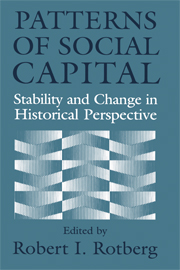Book contents
- Frontmatter
- Contents
- Introduction Social Capital and Political Culture in Africa, America, Australasia, and Europe
- Articles
- Civic Traditions in Premodern Italy
- The Sources of Civil Society in Italy
- Finding Social Capital: The French Revolution in Italy
- Social Capital in the Early Industrial Revolution
- The Diversity of Social Capital in English Communities, 1300–1640 (with a Glance at Modern Nigeria)
- Social and Cultural Capital in Colonial British America: A Case Study
- The Growth of Voluntary Associations in America, 1840–1940
- Civil Society as Democratic Practice: North American Cities during the Nineteenth Century
- Securing Political Returns to Social Capital: Women's Associations in the United States, 1880s–1920s
- Second-Generation Civic America: Education, Citizenship, and the Children of Immigrants
- Human Capital and Social Capital: The Rise of Secondary Schooling in America, 1910–1940
- From Local to National Political Cultures: Social Capital and Civic Organization in the Great Plains
From Local to National Political Cultures: Social Capital and Civic Organization in the Great Plains
Published online by Cambridge University Press: 12 April 2010
- Frontmatter
- Contents
- Introduction Social Capital and Political Culture in Africa, America, Australasia, and Europe
- Articles
- Civic Traditions in Premodern Italy
- The Sources of Civil Society in Italy
- Finding Social Capital: The French Revolution in Italy
- Social Capital in the Early Industrial Revolution
- The Diversity of Social Capital in English Communities, 1300–1640 (with a Glance at Modern Nigeria)
- Social and Cultural Capital in Colonial British America: A Case Study
- The Growth of Voluntary Associations in America, 1840–1940
- Civil Society as Democratic Practice: North American Cities during the Nineteenth Century
- Securing Political Returns to Social Capital: Women's Associations in the United States, 1880s–1920s
- Second-Generation Civic America: Education, Citizenship, and the Children of Immigrants
- Human Capital and Social Capital: The Rise of Secondary Schooling in America, 1910–1940
- From Local to National Political Cultures: Social Capital and Civic Organization in the Great Plains
Summary
It is exciting to think about Putnam's concept of social capital in the context of the semi-arid American Great Plains. Will his theorem hold in an environment so different—in every social and physical sense—from that of urban Italy? Putnam finds that people who form voluntary associations based on common activities or concerns experience greater levels of social integration and political involvement. He calls this civic engagement “social capital” because the power of the group transcends potential individual productivity. Benefits of these reciprocal networks include better community institutions; the building of neighborhood trust, resulting in lower crime rates; and political activism to further local needs. In his work on Italy, Putnam focuses on the overtly political ramifications of social capital. He shows that as regional measures of social capital became stronger in Italy from 1970 to 1989, politicians responded by placing greater emphasis on compromise and efficiency. By pooling resources, citizens were able to alter the prevailing beliefs about government's role and its relationship to the community, which Putnam terms “political culture.” As a result of the active application of social capital, politicians viewed regional loyalty as more important than party affiliation, and citizen satisfaction as a concrete and achievable goal.
Although the title of this article refers to civic organizations, our investigation initially focuses on political participation in gen- eral elections. When we extend it later to local institutions, we turn not to civic institutions (having to do with cities) but to rural institutions—specifically, fifteen publicly owned grasslands, administered in a variety of ways along the communal and democratic spectrum.
- Type
- Chapter
- Information
- Patterns of Social CapitalStability and Change in Historical Perspective, pp. 337 - 374Publisher: Cambridge University PressPrint publication year: 2000

